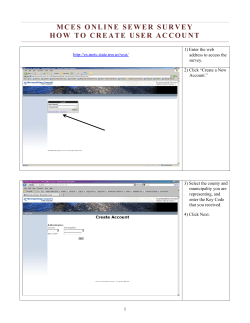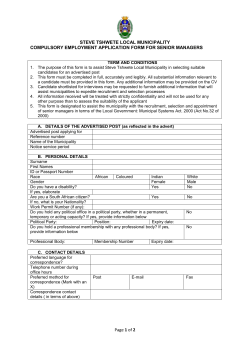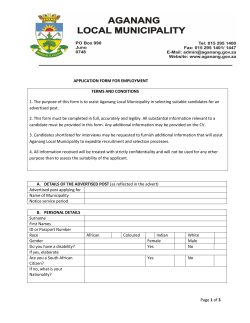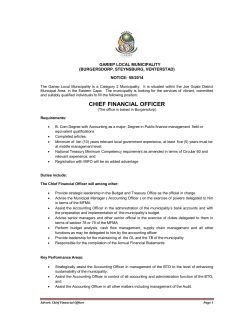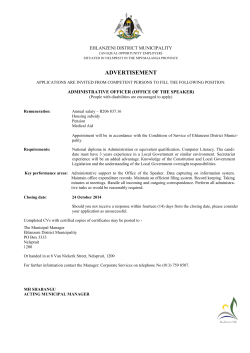
Improving the participation of stakeholder in HIA
Improving the participation of stakeholder in HIA Tools to integrate epidemiology in HIA Nunzia Linzalone Unit of environmental epidemiology Institute of Clinical Physiology - National Council of Research, Pisa Waste. Background • Waste management policies have some shortcomings in protecting health. Major limitations are: – the quantification of modifications in the population health and the environment – the participation of local communities to the waste managment planning and the involvement of local government in the assessment of impacts of different waste treatment strategies Tools. Background • The epidemiological approach (/risk assessment) is able to provide risk estimates in the exposed population • HIA procedure can provide a transparent process that includes both the quantification of impacts, the participation of decision makers and of wide range of stakeholders HIA21 Project. Objectives • INCLUDE THE PUBLIC. A participatory health impact assessment can represents a proper sector of application in the waste management. • INFORM DECISIONS. A methodological gap should be addressed to include evidence in the decison making process. • PROVIDE A FRAMEWORK. A systematic and integrated framework based on openness is needed to assess modifications resulting from the waste management regarding mainly land use, policy planning, thecnological investment, health and environment quality Timeline and major steps The study areas characteristics Focus on the incineration of waste: the case of Arezzo municipality • Political context: opponents parties criticized the authorization process for doubling the power capacity that was underway for the plant • Social context: active groups of civic associations, professional corporations, environmental media, citizens, “doctors for the environment” national headquarter, EPA and LHD interdep. collaboration • Environmental context: highly critical area of “Val di Chaina” for anthropic pressures (different point and linear sources present) HIA21. Model of participation • PARTICIPATION. Tools to build participation were provided from the Agenda21 processes. Forum assembly, focus group laboratories and technical meetings enabled the stakeholder consultations. proposals for methodologies , processes discussion, suggestion evaluation information, discussion , sharing of results Goverment committment • The Arezzo Municipal Councilor endorsed the project goals (City Council resolution n.399 05/09/2012) contributing to: – Data collection, thecnical support, dissemination, public discussion, assessment of impacts – Create inter connections with other municipalities (nearby Civitella municipality), local authorities, plant howner, local initiatives on waste • Introduced changes into the new waste plan ad policy by: – City Council resolution for door-to-door collection, – Dissemination campaigne for waste reduction, – Exclusion of the power plant doubling alternative, – Increase of separate collection from 36% up to 70% Democratic participation of citizens • The bottom up approach was applied. The communities ask for the inclusion of their views in the new waste plan planning process. Focus groups provided: – Addresses for interventions at municipal level – Indicators for monitoring of impacts – Observations to the plan Figures of the participatory impact assessment be timely with the decision! POLICY DEVELOPMENT 2011.09.01 BUILDING OWNERSHIP OF THE PROJECT 2012.04.13 city council urgent question on waste and consultative method 2012.04.16 project leader signs the answer to City council urgent question 2012.04.18 public debate with the San Zeno community 2012.05.17 the case lands in the Region Office 2012.09.05 commitment to the project Life. Act for reduction and recycling 2012.11.19 HIA21 & AR municipality presents the project within EWWR POLICY IMPLEMENTATION SCOPING & APPRISAL REPORTING & MONITORING 2013.11.11 public presentation of preliminary results 2014.02.07 publication of the interprovincial waste plan for observations 2014.06.30 focus groups complete recommendations to decision makers 2014.11.26 waste summit decide more separate and no doubling 2015.03.15 waste service expands the door to door collection 2014.12.31 include all the social actors! • • • • • • • • • • • Civic associations: N. 14 NGO: N. 2 Social Coop.: N. 7 Professional corporate: N. 5 Government institutions: N. 7 (administrative/technical) Private research: N. 4 Political Parties: N. 5 Financing bodies: N. 1 Media and com.: N 2 (regional/local) Business enterprise: N. 2 General public: housewives, retirees, professionals, contractors, workers, teachers, students provide sound evidence! Retrospective Cohort Study on Health Effects in the Population Residing Around the Waste Incinerator 37.700 people living in the area (mean by year) for 2001-2010, were included in the cohort and the individual exposure history to each source was reconstructed to evaluate the mortality and hospitalization risk due to emissions (PM10) . Twelve causes of mortality and hospitalization were linked to the geocoded cohort. Hazard Ratio (HR) was calculated for the exposed population by levels from high to low. Reproductive outcomes: were analysed in a cohort of born from mothers residents nearby the incinerator Conclusions • Government committment in the process is paramount to be effective. Involvement is an opportunity of better governance • Democratic participation of citizens requires a specific methodological adaptation (who, when, how, for what, which output, rules) • Trust can benifit from a transparent and timely process that enables a constant monitoring on interventions • External funding and advice avoid conflict of interest and enable larger participation Further work • Monitoring of impacts of the new waste plan. Specific indicators were developed • Update of environmental, health and socioeconomic databeses for focused analysis i.e. microgeographical scale • Evaluate the communication campaigne, the improvement of the local waste service, the risk perception in the closer area to the plant • Communicate and disseminate results
© Copyright 2025
